Appearance and Size Requirements
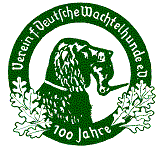
|
GENERAL APPEARANCE:
The Deutscher Wachtelhund is a strong boned, muscular, medium sized gundog with long thick wavy hair. It is solidly-built which allows it to retrieve heavy game such as hares and foxes. The ears are fairly long and should reach from half way to the nose, to the tip of the nose. The size is approximately 18 to 21 inches. Body length, nose to base of tail is twice the height. It is slightly larger than the Springer Spaniel. 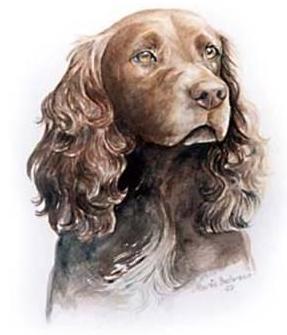 CHARACTERISTICS:
The Wachtelhund has vibrant, affectionate and friendly personality and are willing workers and excellent companions. It is an obsessive scent follower with bloodhound like persistence. The Wachtelhund (quail dog) is easily trained to hunt all types of game. The Germans bred it to be a strong forest dog, built not for speed, but to rummage about the forest. To do many hunting tasks such as; finding game; retrieving and recovering game; blood trailing wounded deer, red stag (elk), and boar. They are used to hunt waterfowl and upland game, all fur and cloven hoof game from hare, fox, and wild boar. They hunt with a high nose, scenting air scents as a pointer when game is far away, and will put their nose to the ground to follow foot scent as a hound when game is close. Unlike hounds they can be called off a trail and will return to their master. They naturally hunt in an arc pattern before the hunter, bringing the game back before the hunter. They are aggressive in the hunt, but are also a loyal and great family dog. They are not pack hunters, but one-on-one hunters and will hold a wounded boar or bear at bay, if necessary. They do best living in the home. Serious faults: Water and gun shyness.
HEAD & SKULL
The head appears strong and free from coarseness, and softly contoured, without sharp angles. As a whole, the parts that make up the head combine to produce the distinctive expression of the breed, that being soft and melting, yet dignified, alert and intelligent. When viewed from either the front or the side, the skull is arched and slightly flattened at the top. When viewed in profile, the brow appears to be not appreciably higher than the back skull without a prominent stop at the eye junction between muzzle and head. When viewed from above, the sides of the skull maintains the approximate planes of the muzzle. The length of the muzzle is equal to the length of the skull, but is narrower, as is consistent with a full eye placement. The head is in proportion to the body, and the muzzle is in proportion to the head. The jaws are strong, indicative that the dog is capable of carrying game. Faults: A prominent stop at the eye junction between muzzle and head.
TEETH:
A full complement of strong, white teeth meeting in a scissors bite. Serious faults: Overshot or undershot bites.
EYES:
The eyes are essential to the overall characteristics of the head. The full, slightly oval-shaped eyes are of medium size and set well apart. The eyelids are tight. The haws are inconspicuous; may be pigmented or not pigmented. The eye color is brown to hazel. 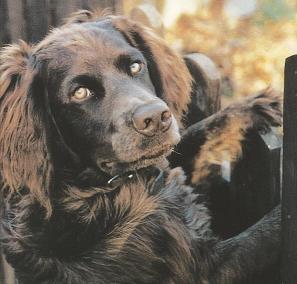 NOSE:
The nostrils are wide, large and flexible, indicative of room for the proper development of olfactory nerve to ensure good scenting ability. Color is brown. EARS:
The ears are high and wide, flat and lie close to the head, without outward turns. The ear leather is fine and extends from half way between the eye and nose to the nose. The ears are covered with long, silky, straight or slightly wavy hair. The hair makes the ear appear large than it is. Faults: Insufficient feathering.
NECK:
The neck is graceful and muscular. It arches toward the head and blends cleanly into sloping shoulders. It is moderate in length and is in balance with the length and height of the dog. Faults: Short, thick, with dewlap.
FOREQUARTERS:
The shoulders are sloping, with the blades flat and smoothly fitting. The shoulder blade and upper arm are approximately equal in length and from an angle of 90 degrees. 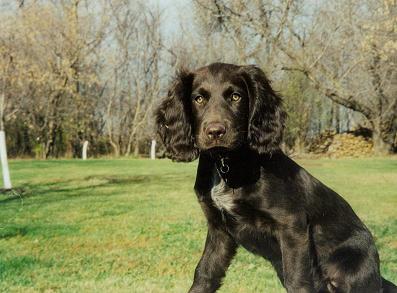 Autumn at 3 months FORELEGS:
The forelegs are strong and straight, with bone that is nearly uniform in size from the elbow to the heel. The elbows are set close to the body. The upper arm is set well back and joins the shoulder with sufficient angulations so that the elbow is placed beneath the highest point of the shoulder blade when the dog is in a natural stance. The pasterns are nearly straight, with some flexibility. From the front view, the legs and feet must be vertical and straight to the ground, the feet are straight forward without turning outward or inward. From the side view, the legs should be slightly angled forward. Bones at the foot and lower leg must have clean joints without protruding bones. Legs should have good feathering from the elbow to the foot. Faults: Loose shoulders. Elbows turned in or out. Knees knuckled over. Bowed legs. Light bones. Feet turned outward or inward.
BODY:
The compact, well-knit body gives the impression of strength. The neckline blends into the shoulder and backline in a smooth curve. The backline slopes very slightly toward the gently rounded croup. The middle back is short and strong, without swayback. The loin is short, wide and deep with slightly bulging muscles to give strength to the hind legs. The loin is very slightly arched, not enough to significantly affect the top line. The croup is gently rounded, without the tendency to fall away sharply. The chest is deep and oval in appearance from the front view. From the side view, the brisket reaches below the elbow. From the front chest is well developed and muscular. The ribs are well-sprung and rounded extending gradually to mid-body tapering to the back ribs, which are of good depth and extend well back. Stomach is flat and fairly level extending from the end of the rib cage to the pelvic area. Faults: Insufficient spring of rib. Withers too low. Flat or narrow loin. Exaggerated tuck-up.
Serious faults: Swayback. Roach back.
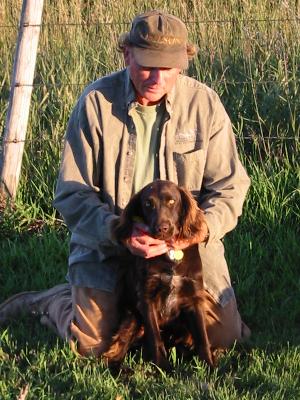 Alke HINDQUARTERS:
The angulations of the hindquarters is in balance with that of the forequarters. The hips are relatively broad and well rounded. LEGS:
The muscular upper thigh is broad and well rounded, providing adequate propelling power. The muscular lower thigh is broad and thick, approximately equal in length to the upper thigh. The stifle is strong and well bent. From the back view, the legs are parallel and straight to the ground, not bowed. The hindquarters have long thick feathering. Faults: Bowed legs. Excessive angulations. Short stifle. Hocks too long. Cowhocks. Weak hocks.
FEET:
The feet are proportionate in size to the legs. They are strong and oval shaped. The toes are arched and tight with thick hair between the toes. The pads are round, thick and course. Faults: Feet too large or too small. Splayed feet.
TAIL:
The tail is slightly docked, 1/5th to 1/3rd set high on the croup. While the dog is in motion, the tail is carried horizontally, an extension of the croup, and is in constant motion. When the dog is excited or working game, the tail may be carried higher, and wags rapidly. The tail has good feathering. Faults: Tail set too low.
COAT:
The coat is short and fine on the head, and of long on the body, where it is strong, thick, wavy or curly, with enough undercoat to provide protection. It is well feathered. Faults: Coat too soft. Thin silky hair. Lack of coat.
COLOR:
The Deutscher Wachtelhund comes mainly in two colors, brown schimmel (brown ticked with white or roaned) and solid brown. Brown/white or schimmel Wachtels will produce coloration ranging from red to dark brown with white ticking, to dogs with large solid brown and solid white patches, to dogs with small brown and white patches called leopards. Brown Wachtelhunds will produce coloration ranging from orange, blond, red, and dark brown; however, brown is the dominant color. Serious faults: Wachtelhunds with black hair color.
SIZE & WEIGHT:
Height, at the withers, for males: 18 7/8 to 21 1/4 inches. Height, at the withers, for females: 17 3/4 to 20 1/2 inches. Wachtelhunds 3/8's to 3/4's of an inch over the standard are not to be disqualified. Size is measured at the back over the shoulder. Desirable weight: 44 to 66 pounds. Serious faults: Any Wachtelhund under 16 1/2 inches.
 Willow GAIT:
The Deutscher Wachtelhund's gait is characterized by drive and the appearance of power, rather than speed, indicative of the breed's use as a hunter in dense cover and upland terrain. Correct angulations enables the dog to cover the ground effortlessly with extension in the front and rear. The head is carried proudly while in motion. The top line remains much the same whether in motion or standing still. They move in a straight line with width between the front and rear appropriate to build and gait. Serious faults: Crabbing. Rolling.
DISQUALIFICATIONS:
Shoulder height at withers under 42 cm (16 1/2 inches). A prominent stop at the eye junction between muzzle and head. Teeth with an under or over bite. Loose eye lids. Thin skeleton or bodied dogs with short backs (body length should be twice the height). Loose shoulder muscles. Crooked or bowed legs and feet turned in or out. Loose drooling lips that do not close. Black hair color. Thin silky hair. Unilateral or bilateral cryptorchid. Viciousness or extreme shyness. Albinism. |
|
For more information or to find a Wachtelhund to purchase, visit wachtelhund.com or contact: John Oberhaus joseph9970@fbcom.net 563-210-8273 |
